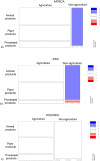Food taboos during pregnancy: meta-analysis on cross cultural differences suggests specific, diet-related pressures on childbirth among agriculturalists
- PMID: 35846875
- PMCID: PMC9281602
- DOI: 10.7717/peerj.13633
Food taboos during pregnancy: meta-analysis on cross cultural differences suggests specific, diet-related pressures on childbirth among agriculturalists
Abstract
Pregnancy is the most delicate stage of human life history as well as a common target of food taboos across cultures. Despite puzzling evidence that many pregnant women across the world reduce their intake of nutritious foods to accomplish cultural norms, no study has provided statistical analysis of cross-cultural variation in food taboos during pregnancy. Moreover, antenatal practices among forager and agriculturalists have never been compared, despite subsistence mode being known to affect staple foods and lifestyle directly. This gap hinders to us from understanding the overall threats attributed to pregnancy, and their perceived nutritional causes around the world. The present study constitutes the first cross-cultural meta-analysis on food taboos during pregnancy. We examined thirty-two articles on dietary antenatal restrictions among agricultural and non-agricultural societies, in order to: (i) identify cross-culturally targeted animal, plant and miscellaneous foods; (ii) define major clusters of taboo focus; (iii) test the hypothesis that food types and clusters of focus distribute differently between agricultural and non-agricultural taboos; and (iv) test the hypothesis that food types distribute differently across the clusters of taboo focus. All data were analysed in SPSS and RStudio using chi-squared tests and Fisher's exact tests. We detected a gradient in taboo focus that ranged from no direct physiological interest to the fear of varied physiological complications to a very specific concern over increased birth weight and difficult delivery. Non-agricultural taboos were more likely to target non-domesticated animal foods and to be justified by concerns not directly linked to the physiological sphere, whereas agricultural taboos tended to targed more cultivated and processed products and showed a stronger association with concerns over increased birth weight. Despite some methodological discrepancies in the existing literature on food taboos during pregnancy, our results illustrate that such cultural traits are useful for detecting perception of biological pressures on reproduction across cultures. Indeed, the widespread concern over birth weight and carbohydrate rich foods overlaps with clinical evidence that obstructed labor is a major threat to maternal life in Africa, Asia and Eurasia. Furthermore, asymmetry in the frequency of such concern across subsistence modes aligns with the evolutionary perspective that agriculture may have exacerbated delivery complications. This study highlights the need for the improved understanding of dietary behaviors during pregnancy across the world, addressing the role of obstructed labor as a key point of convergence between clinical, evolutionary and cultural issues in human behavior.
Keywords: Agriculture; Anthropology; Evolution of human diet; Evolution of human subsistence patterns; Food taboos; Hunter-gatherers; Obstetric dilemma; Obstructed labor; Phenotypic plasticity; Pregnancy.
©2022 Maggiulli et al.
Conflict of interest statement
The authors declare there are no competing interests.
Figures






Similar articles
-
Antenatal Food Avoidances in Madagascar Suggest an Evolutionary Link Between Subsistence Patterns, Carbohydrate Consumption, and Determinants of Obstructed Labor.Am J Biol Anthropol. 2025 Mar;186(3):e70029. doi: 10.1002/ajpa.70029. Am J Biol Anthropol. 2025. PMID: 40108833 Free PMC article.
-
Food-related taboos and misconceptions during pregnancy among rural communities of Illu Aba Bor zone, Southwest Ethiopia. A community based qualitative cross-sectional study.BMC Pregnancy Childbirth. 2021 Apr 17;21(1):309. doi: 10.1186/s12884-021-03778-6. BMC Pregnancy Childbirth. 2021. PMID: 33865339 Free PMC article.
-
Dietary habits, food taboos, and perceptions towards weight gain during pregnancy in Arsi, rural central Ethiopia: a qualitative cross-sectional study.J Health Popul Nutr. 2016 Jul 25;35(1):22. doi: 10.1186/s41043-016-0059-8. J Health Popul Nutr. 2016. PMID: 27456151 Free PMC article.
-
Animal-based food taboos during pregnancy and the postpartum period of Southeast Asian women - A review of literature.Food Res Int. 2019 Jan;115:480-486. doi: 10.1016/j.foodres.2018.10.026. Epub 2018 Oct 9. Food Res Int. 2019. PMID: 30599968 Review.
-
Food taboos and their perceived reasons among pregnant women in Ethiopia: a systematic review, 2022.BMC Pregnancy Childbirth. 2023 Feb 16;23(1):116. doi: 10.1186/s12884-023-05437-4. BMC Pregnancy Childbirth. 2023. PMID: 36797675 Free PMC article.
Cited by
-
The modulation of sustainability knowledge and impulsivity traits on the consumption of foods of animal and plant origin in Italy and Turkey.Sci Rep. 2022 Nov 21;12(1):20036. doi: 10.1038/s41598-022-24325-z. Sci Rep. 2022. PMID: 36414685 Free PMC article.
-
Predictive factors of maternal obesity and its effects on pregnancy symptoms and sexuality: a hospital-based study.BMC Pregnancy Childbirth. 2025 Apr 4;25(1):397. doi: 10.1186/s12884-025-07504-4. BMC Pregnancy Childbirth. 2025. PMID: 40186121 Free PMC article.
-
Food taboo practices and associated factors among pregnant women in Ethiopia: a systematic review and meta-analysis.Sci Rep. 2023 Mar 16;13(1):4376. doi: 10.1038/s41598-023-30852-0. Sci Rep. 2023. PMID: 36927859 Free PMC article.
-
Validation of an Arabic version of the eating disorder inventory's body dissatisfaction subscale among adolescents, adults, and pregnant women.J Eat Disord. 2023 Oct 19;11(1):187. doi: 10.1186/s40337-023-00911-y. J Eat Disord. 2023. PMID: 37858280 Free PMC article.
-
Acceptability of a balanced energy protein (BEP) supplement for pregnant women in Bangladesh.Matern Child Nutr. 2024 Oct;20 Suppl 6(Suppl 6):e13587. doi: 10.1111/mcn.13587. Epub 2023 Nov 22. Matern Child Nutr. 2024. PMID: 37991138 Free PMC article.
References
-
- Aunger R. Are food avoidances maladaptive in the Ituri Forest of Zaire? Journal of Anthropological Research. 1994;50(3):277–310. doi: 10.1086/jar.50.3.3630180. - DOI
Publication types
MeSH terms
LinkOut - more resources
Full Text Sources
Miscellaneous

